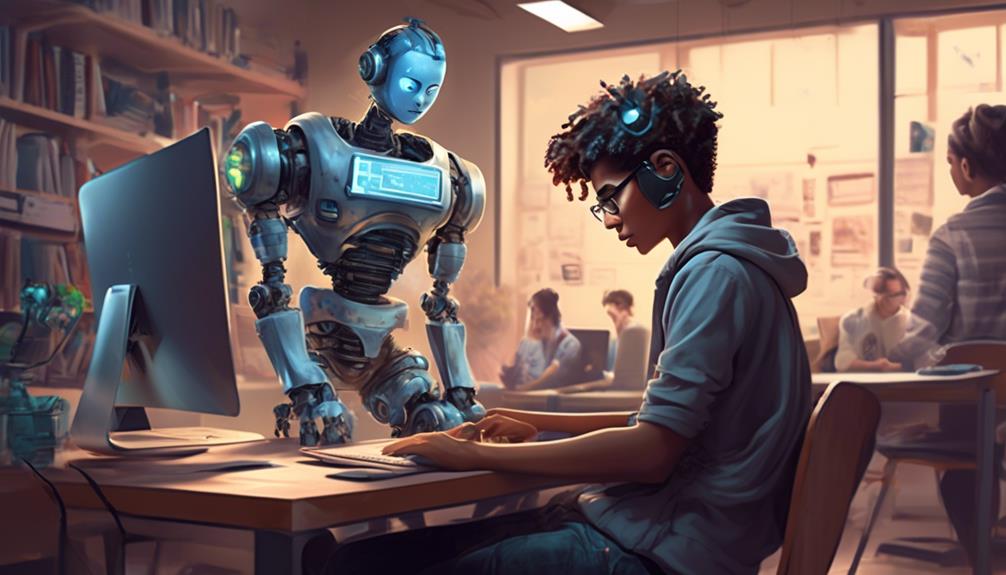In the digital landscape of higher education, chatbots have emerged as the guiding stars, illuminating the path to enhanced student support and engagement.
As we navigate the ever-evolving terrain of technology in academia, the role of chatbots in shaping the student experience becomes increasingly evident.
From personalized assistance to streamlining administrative processes, these AI-powered assistants have sparked discussions and raised questions about their potential impact on the future of education.
Join me as we explore the multifaceted landscape of chatbots in higher education and unravel the complexities and opportunities they present in shaping the learning journey.
Key Takeaways
- Chatbots in higher education enhance student engagement and support, providing emotional support and a sense of belonging.
- They contribute to improved student outcomes by offering timely and personalized assistance.
- Chatbots have demonstrated effectiveness in driving retention and graduation rates.
- Successful implementation of chatbots requires addressing ethical concerns, personalized academic support, and 24/7 availability.
Understanding the Role of Chatbots

Understanding the role of chatbots is crucial in comprehending their impact on student success in higher education. Chatbots, powered by AI technology, have become integral in education institutions by enhancing student engagement and support. These AI-driven chatbots, such as CSUNny and Sunny, have evolved beyond their initial roles in admissions offices. They've proven to be effective in providing emotional support and creating a sense of belonging for students. Their success lies in their ability to form a bond with students while maintaining a comfortable level of human interaction.
In higher education, chatbots have demonstrated their effectiveness in driving retention and graduation rates. By providing timely and personalized support, they contribute to improved student outcomes. Chatbots like CSUNny and Sunny are examples of how AI technology can be harnessed to create a supportive and engaging environment for students. As they continue to evolve, chatbots have the potential to play an even more significant role in driving student success in higher education.
Understanding the role of chatbots in this context is essential for education institutions seeking to leverage AI technology for the benefit of their students.
Best Practices for Higher Education
As we consider best practices for higher education, it becomes evident that the successful integration of chatbots has paved the way for enhanced student support and engagement. AI chatbots in higher education can significantly improve student success by providing personalized academic support and 24/7 availability.
To ensure the effective implementation of chatbots in higher education, the following best practices should be considered:
- Starting as Extensions of Admissions Offices: University chatbots that initially serve as extensions of admissions offices can provide valuable emotional support to prospective students, easing their transition into the university environment.
- Offering Personalized Support and Guidance: Successful chatbots in higher education offer personalized support and guidance to students, addressing their individual needs and concerns.
- Enhancing Retention and Graduation Rates: The use of AI chatbots can drive retention and graduation rates by providing proactive support and intervention to at-risk students.
- Addressing Ethical Concerns: It's crucial for institutions to address ethical concerns related to the use of chatbots, especially regarding the ownership of student data and privacy in higher education.
Impact of Chatbots on Student Success

Chatbots have revolutionized student success in higher education by providing personalized support and guidance, contributing to increased enrollment, graduation rates, and academic achievements. AI chatbots, such as CSUNny and Pounce, have significantly impacted student outcomes, demonstrating their potential to drive success in educational institutions.
These chatbots often start as extensions of admissions offices, offering emotional support and a safe space for students to ask questions. Research suggests that chatbots not only provide academic assistance but also foster a sense of belonging and emotional support, contributing to student success.
Moreover, the capabilities of university's chatbots have significantly improved over time, especially during the COVID-19 pandemic, further enhancing their ability to support students. They've been instrumental in providing guidance on various aspects of student life, including academic advising, financial aid, and teaching and learning resources.
As advancements in AI technology continue, chatbots will play an increasingly vital role in improving student outcomes and contributing to the overall success of students in higher education.
Successful Implementation of Chatbots
The successful implementation of chatbots in higher education has been demonstrated to positively impact enrollment and graduation rates at institutions such as California State University, Northridge, and Georgia State University's chatbot, Pounce.
To ensure the successful implementation of AI chatbots in higher education, a few key factors should be considered:
- Engagement with Key Stakeholders: It's crucial to involve various university departments and leaders, including the vice president of technology and student services, to ensure that the chatbot aligns with the university's strategic goals and meets the needs of both staff and students.
- Customization and Personalization: The successful implementation of chatbots relies on tailoring the AI technology to the specific requirements of the institution and its diverse student population, ensuring that the chatbot provides relevant and personalized support.
- Continuous Improvement: Regular assessment and refinement of the chatbot's functionalities, guided by advancements in artificial intelligence, are essential for the successful implementation of chatbots in higher education, ensuring that the technology remains effective and beneficial to students and staff.
- Accessibility and User Training: Providing accessible resources and training for both students and staff is vital for the successful implementation of AI chatbots, ensuring that everyone can effectively utilize the technology to enhance their university experience.
Case Studies and Examples

Our exploration of successful implementation of chatbots in higher education reveals compelling case studies and examples demonstrating their impact on student enrollment, retention, and academic success.
AI Chatbots like CSUNny at California State University, Northridge, and Pounce at Georgia State University have proven to be valuable tools in the higher education landscape. These chatbots not only make students feel supported but also help in answering questions related to admissions, enrollment, and academic guidance.
As a journalist and editor covering this field, I've come across numerous instances where chatbots have significantly improved student experiences. They've been effective in reducing summer melt, improving student grades and pass rates, and fostering a sense of belonging among students.
The evolution of chatbots in higher education, especially during the COVID-19 pandemic, has highlighted their improved capabilities in providing emotional support and ensuring that students feel welcomed and supported.
These case studies and examples serve as evidence that chatbots can improve student success in higher education by offering personalized support, guidance, and 24/7 accessibility for students.
Frequently Asked Questions
What Is the Use of Chatbots in Higher Education?
We use chatbots in higher education to provide 24/7 support, break down challenging concepts, and assist with course registration and financial aid. They also offer emotional support and maintain connections with students, especially during the COVID-19 pandemic.
What Chatbots Do Universities Use?
We use chatbots at universities to provide support, answer questions, and engage with students. They offer 24/7 availability, assist with difficult concepts, and promote inclusivity. These tools have helped improve enrollment, graduation rates, and student success.
What Are Examples of Educational Chatbots?
We've seen educational chatbots like Mongoose Harmony by Drift, Amazon's QnABot, IBM Watson, and HubBot by HubSpot. These tools have proven effective in driving retention and graduation rates, fostering a sense of belonging for students.
Can Chatbots Be Used in Education?
Yes, chatbots can be used in education to enhance student support and engagement. They provide personalized guidance, emotional support, and create a sense of belonging, ultimately contributing to improved retention and graduation rates.
Conclusion
In conclusion, while some may argue that chatbots could replace human interaction in higher education, it's important to remember that these AI-powered assistants aren't meant to replace, but rather supplement the support and guidance provided by faculty and staff.
By embracing chatbots as a valuable tool for student success, we can ensure that all students have access to the resources and assistance they need to thrive in their academic journey.
Let's work together to create a more inclusive and supportive learning environment for all.
